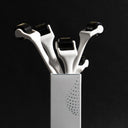Deciding on the right hair growth solution can be daunting, especially when the market offers numerous options. Two of the leading contenders in the hair regrowth arena are Qilib and Rogaine.
But which one reigns supreme? In this comprehensive guide, we will delve deep into the specifics of both products, helping you determine which is better suited to your needs.
Whether you're battling thinning hair or looking for ways to enhance hair density, understanding the Qilib Vs Rogaine debate is crucial. Let's embark on this informative journey to uncover your best choice.
Table of content
What is Qilib?

Qilib is a contemporary line of hair growth and revitalisation products formulated to address hair thinning and loss.
Catering to both men and women, Qilib offers specially designed solutions that aim to rejuvenate the hair and scalp, strengthening the existing hair while promoting the growth of new strands.
Their products utilise scientifically-backed ingredients and herbal extracts to ensure users achieve thicker, fuller, healthier hair.
How does Qilib work?
Qilib addresses hair thinning at the source, revitalises hair follicles and improves scalp health to encourage hair regrowth.
What are the key ingredients in Qilib?
- Minoxidil: A proven hair growth stimulant.
- Biotin: Vital for hair health and strength.
- Herbal extracts: Natural enhancers for hair thickness and vitality.
- DHT blockers: Prevents hair thinning caused by Dihydrotestosterone.
- Vitamins and nutrients: Essential for maintaining overall hair health.
Are there any side effects of Qilib?
Qilib's primary active ingredient, Minoxidil, can lead to side effects in some individuals. These may include scalp irritation, increased heart rate, hair growth in unintended areas, and, in rare cases, allergic reactions. Always consult with a healthcare professional before starting any new hair treatment.
As your leading source for hair health information over the past 4 years, we never compromise on accuracy. When it comes to your health, you deserve information you can truly rely on - and earning your trust is our top priority.
Here's how Scandinavian Biolabs ensures every piece of content meets the highest standards of accuracy and integrity:
- Credentialed Experts: Our reviewers are actively practicing doctors and medical researchers
- Stringent Reviews: Content undergoes rigorous editing by subject specialists and review by a practicing doctor.
- Evidence-Based: We rely on well-established research from trusted scientific sources like peer-reviewed journals and health authorities.
- Full Transparency: Our editorial standards, writer credentials, reviewer credentials, correction process, and funding are all publicly documented.
- Independent Voice: While we do promote products, we operate in a vacuum to business operations. Our main goal is just an unwavering commitment to providing medically-sound guidance.
You can count on Scandinavian Biolabs to consistently deliver the trustworthy health information you deserve. Read our Editorial Standards.
What is Rogaine?

Minoxidil, commonly known as Rogaine, is a topical solution to tackle hair loss and encourage regrowth. Originally intended as a high blood pressure medication, an intriguing side effect emerged: spontaneous hair growth.
Now, it stands as one of the most sought-after over-the-counter treatments for hair loss, offered in varied potencies and embraced by a global audience.
Rogaine functions by extending the growth cycle of hair follicles, leading to increased hair growth and reduced hair loss. Typically applied directly to the scalp about twice daily, it has proven its efficacy for both genders.
Although Rogaine doesn't completely reverse baldness, it plays a significant role in decelerating its onset and, in some cases, fosters hair regrowth.
How does Rogaine work?
Rogaine, or Minoxidil, enhances blood circulation to the applied regions, predominantly the scalp. This action is thought to prolong the hair follicle cycle's anagen phase (the growth phase), yielding longer and denser hair strands.
Moreover, it might amplify the size of the hair follicle, producing thicker hair. Through these mechanisms, Rogaine combats hair loss and fosters hair regrowth, benefiting those grappling with pattern baldness or diminishing hair density.
What are the key ingredients in Rogaine?
Rogaine, popularly recognised by its generic name, Minoxidil, is a hair regrowth solution applied directly to the scalp. The core active element in Rogaine is Minoxidil. Minoxidil functions as a vasodilator, which means it expands blood vessels.
Conceived initially as a medication to address high blood pressure, an intriguing side effect emerged: users began to display enhanced hair growth. This unexpected result prompted the creation of a topical version tailored for promoting hair regrowth.
In addition to Minoxidil, Rogaine's composition might include other inactive components like alcohol, propylene glycol, and water to stabilise or deliver the active substance.
The inactive components might differ depending on the Rogaine variant (e.g., foam vs. liquid) and its target audience (like formulations for men vs. women).
Are there any side effects of Rogaine?
Minoxidil, regardless of its branding, can lead to several side effects:
- Local Irritation: Among the most frequent side effects, users might encounter itching, redness, peeling, or a burning sensation where the product is applied. This sensation could be linked to the increased blood circulation induced by the medication.
- Allergic Contact Dermatitis: Some users might exhibit allergic reactions, showcasing symptoms akin to local irritation, such as itching and redness.
- Anaphylaxis: A considerably rare yet intense allergic response, it can manifest symptoms like hives, an all-over body rash, feelings of nausea, vomiting, and swelling in areas like the lips and tongue. Encountering these symptoms necessitates immediate cessation of the product and urgent medical attention.
- Increased Hair Shedding: Some users notice an uptick in hair loss upon initiating the treatment, often termed 'minoxidil shedding'. This is due to dormant hair follicles releasing existing hair to pave the way for newer, healthier growth.
An effective alternative to Qilib and Rogaine

The Bio-Pilixin® Serum by Scandinavian Biolabs offers an advanced approach aimed at addressing the appearance of hair loss and supporting new growth.
This serum is enriched with several plant growth factors using advanced stem cell technology, ensuring deep nourishment and invigorating growth from the roots.
Clinical studies indicate that users have observed results within 45 days. In fact, 93% of participants reported positive outcomes during the study.
Formulated daily, this botanical-inspired serum promises optimal nourishment and rejuvenation for your tresses. Every ingredient is of premium quality, handpicked based on rigorous scientific scrutiny.
One standout ingredient, Capilia Longa, derived from Curcuma longa stem cells, has been clinically validated to reduce hair loss by an impressive 89–90% and boost hair density by 52%.
Niacinamide enhances the formula, fortifying hair by bolstering blood circulation and defending follicles against early deterioration due to environmental factors like pollution and UV rays.
These key components contribute to making the Bio-Pilixin® Serum a noteworthy option in the realm of hair care solutions.
Trust in our assurance: we provide a money-back guarantee if, after 150 days, you find the results less than satisfactory.
Qilib vs Rogaine: What are the differences?
Qilib and Rogaine are prominent names in the hair regrowth industry, yet they approach the hair loss challenge with distinct formulations and mechanisms of action. While they aim to promote hair growth and curbing hair loss, their ingredients, application methods, and potential side effects set them apart.
Active ingredients
Rogaine is primarily known for its active ingredient, Minoxidil. Minoxidil is a vasodilator, initially developed for high blood pressure but later found effective in promoting hair growth.
On the other hand, Qilib features a blend of ingredients, including biotin, herbal extracts, and DHT blockers, designed to provide comprehensive hair health.
Mode of action
Rogaine increases blood flow to the hair follicles, stimulating and prolonging the hair's growth phase.
Qilib's approach is multifaceted; it aims to promote hair growth and focuses on strengthening existing hair and creating a healthy scalp environment through its various ingredients.
Application methods
While both products are topical treatments applied directly to the scalp, there can be differences in the recommended frequency and application method.
Rogaine is typically suggested to be used twice daily, whereas Qilib's application might vary based on the product and formulation.
Potential side effects
Minoxidil, the active ingredient in Rogaine, can lead to side effects like scalp irritation, increased heart rate, and, in rare cases, allergic reactions.
Qilib, with its diverse blend of ingredients, can also have side effects depending on an individual's sensitivity to any particular component, though specifics will vary by product and its formulation.
Target audience
Both Rogaine and Qilib cater to both men and women. However, there are specific formulations of Rogaine designed exclusively for men or women due to the different strengths of Minoxidil used.
Qilib also offers solutions tailored to various hair concerns, ensuring a comprehensive approach to hair health for all users.
Qilib vs Rogaine: Which one is better for you?
Qilib and Rogaine are both reputable brands in the hair regrowth industry. With its active ingredient, Minoxidil, Rogaine is well-established and proven effective for many users. Meanwhile, Qilib uses a blend of ingredients, including biotin and herbal extracts, aiming for comprehensive hair health.
The best choice between Qilib and Rogaine depends on individual needs, sensitivity to ingredients, and specific hair concerns. Consulting with a dermatologist or hair care specialist can provide personalised advice.
Conclusion
Deciding between Qilib and Rogaine hinges on individual needs and hair challenges. While Rogaine's Minoxidil base has a well-established reputation, Qilib offers a multifaceted approach with diverse ingredients.
Yet, alternative solutions like the Bio-Pilixin Serum shouldn't be overlooked. It's a noteworthy option in the area of hair appearance improvement, formulated with advanced stem cell technology and key ingredients like Capilia Longa.
Finding a product that works for you may take some time, but prioritizing quality hair care products is often considered a good approach.
Resources:
- https://pubmed.ncbi.nlm.nih.gov/12196747/
- https://www.ncbi.nlm.nih.gov/books/NBK482378/
- https://www.ncbi.nlm.nih.gov/books/NBK278957/
- https://www.ncbi.nlm.nih.gov/pmc/articles/PMC2938579/
- https://pubmed.ncbi.nlm.nih.gov/2180995/
- https://pubmed.ncbi.nlm.nih.gov/3549804/
Read more:






